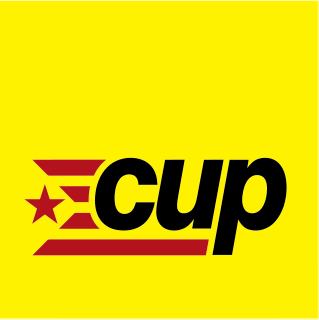Related Research Articles
ISO 8601 is an international standard covering the worldwide exchange and communication of date- and time-related data. It is maintained by the Geneva-based International Organization for Standardization (ISO) and was first published in 1988, with updates in 1991, 2000, 2004, and 2019. The standard aims to provide a well-defined, unambiguous method of representing calendar dates and times in worldwide communications, especially to avoid misinterpreting numeric dates and times when such data is transferred between countries with different conventions for writing numeric dates and times.

The Institute for Catalan Studies, also known by the acronym IEC, is an academic institution which seeks to undertake research and study into "all elements of Catalan culture". It is based in Barcelona, Spain.

The Catalan Countries refers to those territories where the Catalan language is spoken. They include the Spanish regions of Catalonia, the Balearic Islands, Valencia, and parts of Aragon and Murcia (Carche), as well as the Principality of Andorra, the department of Pyrénées-Orientales in France, and the city of Alghero in Sardinia (Italy). In the context of Catalan nationalism, the term is sometimes used in a more restricted way to refer to just Catalonia, Valencia and the Balearic Islands. The Catalan Countries do not correspond to any present or past political or administrative unit, though most of the area belonged to the Crown of Aragon in the Middle Ages. Parts of Valencia (Spanish) and Catalonia (Occitan) are not Catalan-speaking.

TV3 is the primary television channel of Catalan public broadcaster Televisió de Catalunya, a subsidiary of the CCMA. TV3 broadcasts programmes only in Catalan, with an optional dual track in the original language for some foreign-language series and movies, although Spanish is not dubbed or subtitled. TV3 is also a founding member of FORTA, the Federation of Autonomic Radio and Television Organizations of Spain. It is funded by the regional autonomous government, the Generalitat de Catalunya, through the CCMA.
Different conventions exist around the world for date and time representation, both written and spoken.

Catalunya Ràdio is Catalonia's public radio network. With headquarters in Barcelona, it is part of the Corporació Catalana de Mitjans Audiovisuals (CCMA), owned by the Generalitat de Catalunya.

El 33 is Catalonia's second public television channel. It belongs to Televisió de Catalunya, a subsidiary of the CCMA.

The Popular Unity Candidacy is a left-wing to far-left pro-Catalan independence political party active primarily in Catalonia, where it has political representation, but also in other autonomous communities in Spain it considers to be part of the Catalan Countries. The CUP traditionally has focused on municipal politics, and is made up of a series of autonomous candidatures that run in local elections. Its presence is strongest within the contemporary Catalonia autonomous community.
The Czech Republic hosts two different standardized forms of date and time writing.
In Spain, date notation follows the date, month, year date order. Time notation depends on the formality and varies in writing and speaking. Official time is given using the 24-hour clock, and the 12-hour clock is often used when speaking informally.
Date and time notation in Sweden mostly follows the ISO 8601 standard: dates are generally written in the form YYYY-MM-DD. Although this format may be abbreviated in a number of ways, almost all Swedish date notations state the month between the year and the day. Months are not capitalised when written. The week number may also be used in writing and in speech. Times are generally written using 24-hour clock notation, with full stops as separators, although 12-hour clock notation is more frequently used in speech.
The European Committee for Standardization (CEN) and European Committee for Electrotechnical Standardization (CENELEC) adopted ISO 8601 with EN 28601, now EN ISO 8601. As a European Norm, CEN and CENELEC member states are obligated to adopt the standard as national standard without alterations as well.
Date and time notation in Italy records the date using the day–month–year format. The time is written using the 24-hour clock (16:35); in spoken language and informal contexts the 12-hour clock is more commonly adopted, but without using "a.m." or "p.m." suffixes (4:35).

The 2011 Barcelona City Council election, also the 2011 Barcelona municipal election, was held on Sunday, 22 May 2011, to elect the 9th City Council of the municipality of Barcelona. All 41 seats in the City Council were up for election. The election was held simultaneously with regional elections in thirteen autonomous communities and local elections all throughout Spain.

The 1984 Catalan regional election was held on Sunday, 29 April 1984, to elect the 2nd Parliament of the autonomous community of Catalonia. All 135 seats in the Parliament were up for election.

The Catalan time system is the traditional manner in which to tell time in Catalan, and it is exclusive to this language. Telling the time through this system works by dividing it in fractions of a quarter and half a quarter of an hour. Hour-fractions refer to the starting hour, taking into account that when a clock reaches a whole hour it actually indicates its end.

The coat of arms of Barcelona is the official emblem of the City Council of Barcelona, the capital of Catalonia, has its origin in the Middle Ages, these arms were first documented in 1329. The Government of Catalonia conferred the coat of arms and the flag as official symbols of the municipality in 2004. It has an escutcheon in lozenge which is commonly used in municipal coats of arms of cities in Catalonia. Currently the City Council of Barcelona also uses an isotype based on the heraldry of the city.
References
- ↑ 0141 reduim els dies de la setmana Archived 25 February 2016 at the Wayback Machine Optimot, Consultes lingüístiques.
- ↑ Abreviatures Archived 2 June 2015 at the Wayback Machine , Societat d'Onomàstica
- 1 2 3 Un Rellotge Català: Bibliografia, enllaços i agraïments (in Catalan)